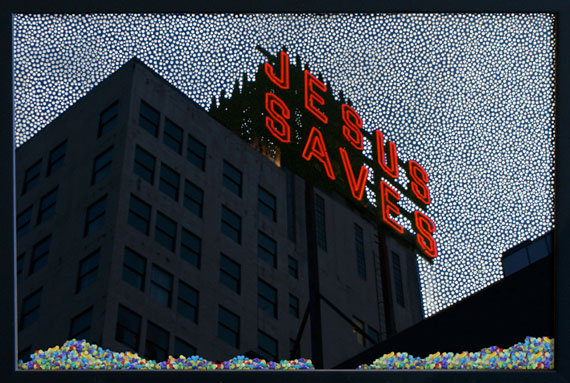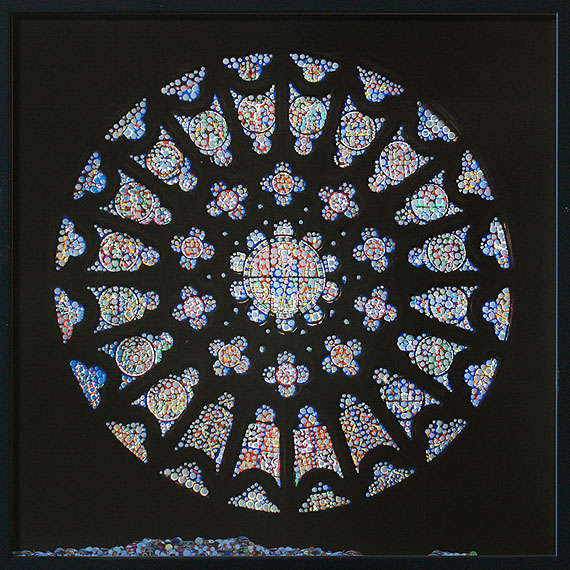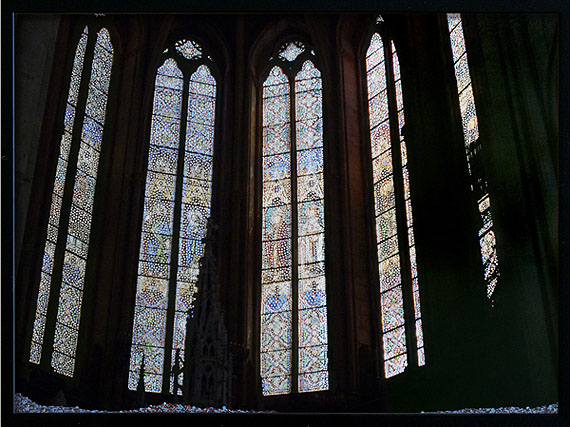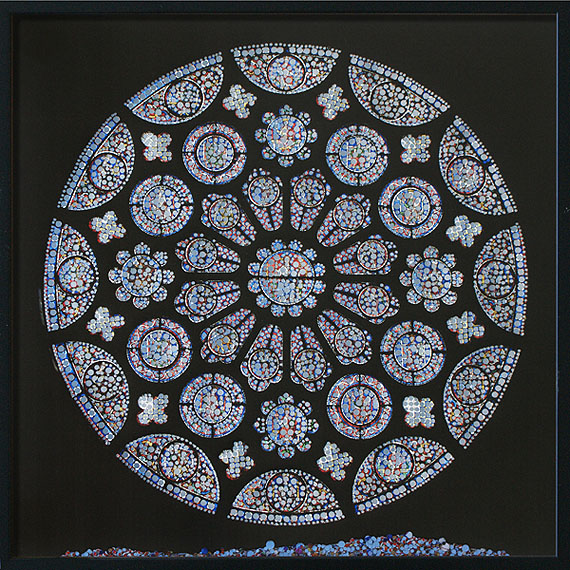
2010
Perforated C-print, confetti, frame
66 x 100 cm
Edition 5
Miguel Rothschild »
Happy Believers
Exhibition: 16 Jun – 28 Jul 2012

Kuckei + Kuckei
Linienstr. 107/108
10115 Berlin
+49 (0)30-8834354
info@kuckei-kuckei.de
www.kuckei-kuckei.de
Tue-Fri 11-18, Sat 11-17

Perforated inkjet print, confetti, frame
50 x 50 cm
Edition 2
Miguel Rothschild
Happy Believers
June 16 – July 28, 2012
Kuckei + Kuckei is very pleased to announce their first solo exhibition with Miguel Rothschild in Berlin.
Miguel Rothschild borrows his motifs from a Christian or rather an art-historical context. He also employs Gothic church windows, confessional boxes, as well as depictions of the Holy Ghost and of Jesus risen from the dead. Religion and art serve as source and as inspiration, with the twin aim of exploiting the gravitas of an entire cosmos of meaning and of staging pathos. With this intervention, he metamorphoses and transforms Catholicism and its image-worlds. Many of Rothschild's works use chiaroscuro contrasts that heighten spatial effects while at the same time providing a Romantic pictorial motif. These works might be seen as extending the basic concept of photography. Rothschild's photographs become a foil, or source of inspiration, and thus a first level and point of polarisation.
Offenbarung, a series of fourteen works, displays examples of rose windows in Gothic churches and cathedrals. Their motifs range from figurative scenes of resurrection to stylised floral patterns. Confetti, produced during the perforation process, collects at the foot of the frame – as an element of lightness which Rothschild opposes to the pathos of religion. By perforating the templates, Rothschild reveals a new level, offering a plastic invitation to look behind the objects. A room that until then had remained hidden can now be explored. Rothschild is not interested in copying, but in transforming pictorial information to create new visual content.
In The Birds II, Miguel Rothschild employs the two contrasting image worlds of religion and film, based on a still from Hitchcock's eponymous film The Birds. Rothschild's birds, however, are depictions of the Holy Ghost borrowed from artworks dating from the thirteenth to the nineteenth centuries. In a second part of the picture, which supplements the work to create a diptych, an additional level appears: a graphic presentation of the scene with a detailed legend on the origins of portrayals of the Holy Ghost. The diptych thus embodies a double break at the levels of fiction and myth.
The works in the Absolution series stand out immediately due to their playful quality. Photographs of the latticework in Italian confessionals dating from the sixteenth to the nineteenth century form the pictorial background. The photographs are perforated at places corresponding to the gaps in the lattices, which are populated with small metal balls. Visitors are challenged to try their luck at this game and get the balls in the holes. The impression of a game of skill is thus created against the background of countless serious and minor transgressions that have been whispered through these lattices down through the centuries.
In the works exhibited, Miguel Rothschild succeeds in creating a balance by combining the religiously charged and iconic pictorial themes with everyday elements. For Rothschild, this contrast forms the core element in his works. The exhibits displayed straddle a variety of artistic genres, ranging from photographs to mixed mixed-media objects and installative works. In Happy Believers, he plays once again with the tension between tradition and revolt, and demonstrates that it is sometimes possible to live in both worlds at once.
Felices los que creen sin haber visto
2011
perforated c-print, confetti
113 x 150 cm | 44 x 59 inches
Edition of 5
Miguel Rothschild (*1963 in Buenos Aires, Argentina) lives and works in Berlin. He graduated from la Escuela Nacional de Bellas Artes de Buenos Aires and from the Hochschule der Künste Berlin at the masterclass of Prof. Rebecca Horn. A selection of his recent exhibition projects: «Punkt.Systeme» Wilhelm-Hack-Museum Ludwigshafen (2012), «Felices los que creen sin haber visto», Ruth Benzacar, Buenos Aires (2012), «Images de la Mélancolie» Bendana Pinel Art Contemporain (2012), «Examples to follow! Expeditions in aesthetics and sustainability», Bauhaus Dessau, Dessau (2011), «HEIMATKUNDE - How German is it? 30 Artists Notion of Home», Jüdisches Museum in Berlin (2011), «Art of the 90s in Malba Collection. Works 1989 -2010, Malba» from the Fundación Costantini at the Museo de Arte Latinoamericano de Buenos Aires (2011), «The Messiah Fights Back», Kunstverein Hannover, Hanover (2009), «Máquinas de mirar», Centro Andaluz de Arte Contemporáneo, Seville (2009). «33 traurige Tragödien, Kunstraum» at Potsdam (2008), «Daumenkino», Kunsthalle Düsseldorf, «Düsseldorf (2005), «Le 10 neuf», Centre Régional d’Art Contemporain, Montbeliard (2004).

2011
perforated c-print, confetti
113 x 150 cm | 44 x 59 inches
Edition of 5
Miguel Rothschild
Happy Believers
16. Juni – 28. Juli 2012
Kuckei + Kuckei freut sich die erste Einzelausstellung von Miguel Rothschild in ihren Räumen in Berlin ankündigen zu können.
Miguel Rothschild entlehnt seine Motive aus einem christlichen bzw. kunsthistorischen Kontext. Gotische Kirchenfenster greift er ebenso auf, wie Beichtstühle und Darstellungen des Heiligen Geistes oder des auferstandenen Christus. Religion und Kunst sind dabei Quelle und Inspiration mit dem Ziel, die Gravitas des gesamten Bedeutungskosmos auszuschöpfen und Pathos zu inszenieren bzw. in Frage zu stellen. Der Katholizismus und seine Bilderwelten werden durch seinen Eingriff verwandelt und umgeformt. Viele seiner Arbeiten werden von einem Clair-obscur-Kontrast begleitet, der ihm zur Steigerung des Räumlichen und als Bildmotiv der Romantik dient. Miguel Rothschilds Arbeiten lassen sich einem erweiterten Fotografie-Begriff zuordnen. Die Fotografien werden zur Folie oder Inspiration und damit zu einer ersten Ebene und Polarisationspunkt.
Offenbarung, eine Serie von 14 Arbeiten, zeigt Rosetten aus gotischen Kirchen und Kathedralen. Die Motive reichen von figürlichen Auferstehungsszenen bis zu stilisierten, floralen Mustern. Am Boden des Rahmens sammelt sich das bei dem Lochungsprozess entstandene Konfetti – ein Element der Leichtigkeit, welches Rothschild dem Pathos der Religion entgegensetzt. Durch die Lochung der Vorlagen eröffnet Rothschild eine neue Ebene – eine plastische Einladung, hinter die Dinge zu schauen. Ein bis dahin verborgen gebliebener Raum kann erkundet werden. Es ist nicht in Rothschilds Interesse abzubilden, sondern durch die Transformation der Bildinformation neue Bildinhalte zu generieren.
In The Birds II verwendet Miguel Rothschild die zwei gegensätzlichen Bilderwelten von Religion und Film. Basis ist ein Filmstill aus Hitchcocks Klassiker Die Vögel. Rothschilds Vögel sind allerdings Darstellungen des Heiligen Geistes aus Kunstwerken des 13. bis 19. Jahrhunderts. Als zusätzliche Ebene entsteht in einem zweiten Bildteil, das die Arbeit zum Diptychon ergänzt, eine graphische Darstellung der Szene mit Angaben zur Herkunft der Heiligen Geister. Das Diptychon zeigt damit einen doppelten Bruch von Fiktion und Mythos.
Die Arbeiten der Serie Absolution fallen sofort durch ihre spielerische Qualität auf. Als Bildgrund dienen Fotografien der Gitter italienischer Beichtstühle aus dem 16. bis 18. Jahrhundert. Die Fotografien erhalten Lochungen an den Stellen der Gitter und werden mit einer Anzahl an kleinen Metallkugeln bestückt, die der Lochungen des Gitters entsprechen. Der Besucher ist aufgefordert, sich in diesem Spiel zu versuchen und die Kugeln in die vorgesehenen Löcher zu platzieren. So entsteht der Eindruck eines Geschicklichkeitsspiels auf der Folie von unzähligen größeren und kleineren Vergehen, die über die Jahrhunderte durch diese Gitter geflüstert wurden.
In den ausgestellten Werken entsteht eine Balance aus religiös überhöhten Bildthemen gepaart mit alltäglichen Elementen. Dieser Gegensatz ist für Miguel Rothschild das Kernelement seiner Arbeiten. Die Werke der Ausstellung bewegen sich zusätzlich in verschiedenen Kunstgattungen. Die Bandbreite reicht von Fotografien über Mixed- Material-Objekte bis hin zu installativen’ Arbeiten. Für Happy Believers spielt er einmal mehr mit dem Spannungsbogen aus Tradition und Revolte und beweist, dass man manchmal auch beides leben kann.
Miguel Rothschild (*1963 in Buenos Aires, Argentinien) lebt und arbeitet in Berlin. Er studierte an der Escuela Nacional de Bellas Artes de Buenos Aires und der Hochschule der Künste Berlin (Abschluss in der Meisterklasse von Prof. Rebecca Horn). Eine Auswahl seiner letzten Ausstellungprojekte: «Punkt.Systeme» Wilhelm-Hack-Museum Ludwigshafen (2012), «Felices los que creen sin haber visto», Ruth Benzacar, Buenos Aires (2012), «Images de la Mélancolie» Bendana Pinel Art Contemporain (2012), «Examples to follow! Expeditions in aesthetics and sustainability», Bauhaus Dessau, Dessau (2011), «HEIMATKUNDE - How German is it? 30 Artists Notion of Home», Jüdisches Museum in Berlin (2011), «Art of the 90s in Malba Collection. Works 1989 -2010, Malba» from the Fundación Costantini at the Museo de Arte Latinoamericano de Buenos Aires (2011), «The Messiah Fights Back», Kunstverein Hannover, Hanover (2009), «Máquinas de mirar», Centro Andaluz de Arte Contemporáneo, Seville (2009). «33 traurige Tragödien, Kunstraum» at Potsdam (2008), «Daumenkino», Kunsthalle Düsseldorf, «Düsseldorf (2005), «Le 10 neuf», Centre Régional d’Art Contemporain, Montbeliard (2004).

2011
perforated inkjet print, confetti
50 x 50 cm | 19 x 19 inches
Edition of 2